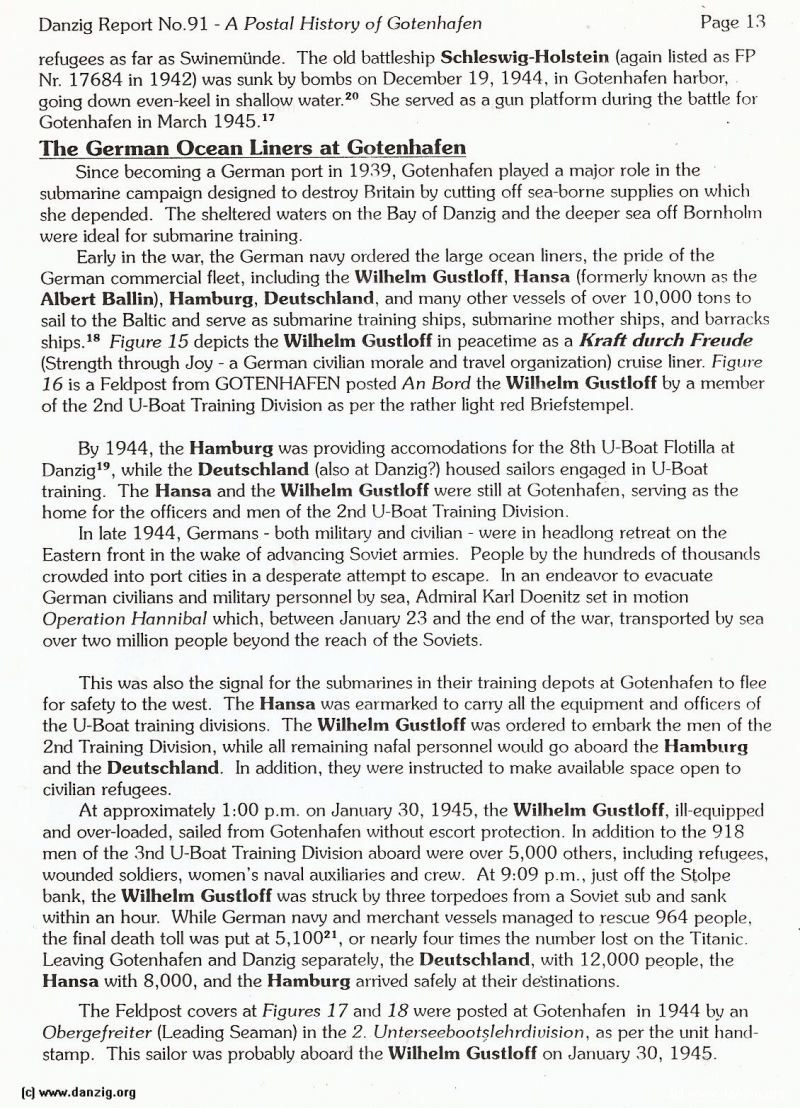
refugees as far as Swinemunde. The old battleship Schleswig-Holstein (again listed as FP Nr. 17684 in 1942) was sunk by bombs on December 19, 1944, in Gotenhafen harbor, going down even-keel in shallow water.2° She served as a gun platform during the battle for Gotenhafen in March 1945.’
The German Ocean Liners at Gotenhafen
Since becoming a German port in 1939, Gotenhafen played a major role in the submarine campaign designed to destroy Britain by cutting off sea-borne supplies on which she depended. The sheltered waters on the Bay of Danzig and the deeper sea off T3ornholm were ideal for submarine training.
Early in the war, the German navy ordered the large ocean liners, the pride of the German commercial fleet, including the Wilhelm Gustioff, Ilansa (formerly known as the Albert Baum), Hamburg, Deutschland. and many other vessels of over 10,000 tons to sail to the Baltic and serve as submarine training ships, submarine mother ships, and barracks ships.18 Figure 15 depicts the Wilhelm Gustloff in peacetime as a Kraft durch Freude (Strength through Joy - a German civilian morale and travel organization) cruise liner. Figure 16 is a Feldpost from GOTENHAFEN posted An Bord the Wilhelm Gustloff by a member of the 2nd U-Boat Training Division as per the rather light red Briefsternpel.
By 1944, the Hamburg was providing accornodations for the 8th U-Boat Flotilla at Danzig’9, while the Deutschland (also at Danzig?) housed sailors engaged in U-Boat training. The Hansa and the Wilhelm Gustloff were still at Gotenhafen, serving as the home for the officers and men of the 2nd U-Boat Training Division.
In late 1944, Germans - both military and civilian - were in headlong retreat on the Eastern front in the wake of advancing Soviet armies. People by the hundreds of thousands crowded into port cities in a desperate attempt to escape. In an endeavor to evacuate German civilians and military personnel by sea, Admiral Karl Doenitz set in motion Operation Hannibal which, between January 23 and the end of the war, transported by sea over two million people beyond the reach of the Soviets.
This was also the signal for the submarines in their training depots at Gotenhafen to flee for safety to the west. The Hansa was earmarked to carry all the equipment and officers of the U-Boat training divisions. The Wilhelm Gustloff was ordered to embark the men of the 2nd Training Division, while all remaining nafal personnel would go aboard the l-Iamburg and the Deutschland. In addition, they were instructed to make available space open to civilian refugees.
At approximately 1:00 p.m. on January 30, 1945, the Wilhelm Gustloff, ill-equipped and over-loaded, sailed from Gotenhafen without escort protection. In addition to the 918 men of the 3nd U-Boat Training Division aboard were over 5,000 others, including refugees, wounded soldiers, women’s naval auxiliaries and crew. At 9:09 p.m., just off the Stolpe bank, the Wilhelm Gustloff was struck by three torpedoes from a Soviet sub and sank within an hour. While German navy and merchant vessels managed to rescue 964 people. the final death toll was put at 5,10021, or nearly four times the nuriiber lost on the Titanic. Leaving Gotenhafen and Danzig separately, the Deutschland, with 12,000 people, the Hansa with 8,000, and the Hamburg arrived safely at their destinations.
The Feldpost covers at Figures 17 and 18 were posted at Gotenhafen in 1944 by an Obergefreiter (Leading Seaman) in the 2. Unter.seehoot.dehrdivision, as per the unit hand- stamp. This sailor was probably aboard the Wilhelm Gustloff on January 30, 1945.
Danzig Report Vol. 1 - Nr. 91 - April - May - June - 1996, Page 13.
Hits: 3280
Added: 13/07/2015
Copyright: 2025 Danzig.org

